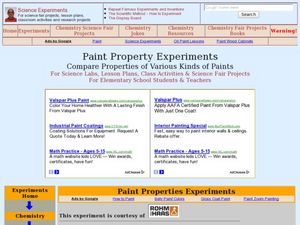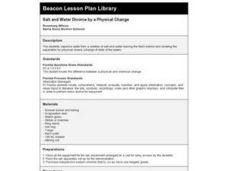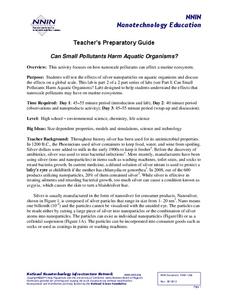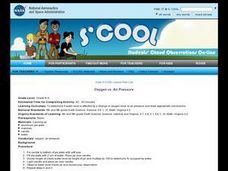Curated OER
The Solar System: Why do we Explore?
Third graders act as scientists. In this property discovery lesson, 3rd graders explore the substance "Oobleck" (cornstarch, water, food coloring). They work in groups to investigate the substance and make observations as a scientist...
Curated OER
Paint Property Experiments
Students identify various kinds of paints by using the scientific method. In this solvents lesson students collect data and identify paint samples while working in teams.
Curated OER
Salinity Lab
In this salinity learning exercise, learners simulate conditions of salt and fresh water mixing and observe the various densities of these solutions based on their salinity.
Curated OER
Salt and Water Divorce by a Physical Change
Students discuss the definitions of physical and chemical properties and changes. They vaporize a solution of salt and water, observing the sodium chloride that is left behind.
Curated OER
Am I Neutral? pH Properties in Soil
Pupils participate in a science lab to determine the pH of three different soil samples. Students conduct an experiment by creating a question, a hypothesis and then an investigation of soil samples. Then they compare colors apprearing...
Curated OER
Denaturing Proteins
Young scholars investigate how to denature proteins. For this denaturing protein lesson plan, students explore the different ways to denature proteins in the lab. They use heat, acids and bases, organic compounds and heavy metals to...
Curated OER
What's The Scoop?
Students explore the properties of matter. In this cross curriculum three states of matter science lesson, students listen to the poem "Eighteen Flavors" by Shel Silverstein, and predict what will happen if listed ingredients are...
American Chemical Society
Liquids - Clearly Unique
Bring chemistry to life for scholars as they perform two tests to examine the unique properties of three liquids. Classroom investigators make observations, develop basic lab skills, and follow step-by-step instructions to compare water,...
Curated OER
Acids and Alkalis
This PowerPoint progresses slide-by-slide through all the facts you would want to deliver about acids, alkalis, salts, and the related lab tests. Each slide has one or two facts about a physical or chemical property or behavior. The...
Curated OER
Project Geode
Students predict the appearance of a geode's internal structure based on its mass and density. They form a hypothesis based on the data they collect. They also identify common minerals found in Illinois.
Curated OER
Ocean Floor Properties and Near Shore Environments
Students explore and model the characteristics of the ocean floor and near shore environments through in-class demonstrations, laboratory activities, and internet research. They use classroom materials to research the characteristics of...
National Nanotechnology Infrastructure Network
Can Small Pollutants Harm Aquatic Organisms?
Nanoparticles have toxic effects on plant and animal life—even though you can't see them. The second lesson of a two-part series has young scientists conduct an experiment that exposes plant and animals to nanoparticle pollutants. They...
Kenan Fellows
Sustainability: Learning for a Lifetime – Soil
Do great gardeners really have green thumbs—or just really great soil? Environmental scholars discover what makes Earth's soil and soil quality so important through research and experimentation. Learners also develop an understanding of...
Texas State Energy Conservation Office
Investigation: Oil Recovery
Energy conservers investigate gravel size to discover if it impacts the amount of oil recovered in the extraction process.
Curated OER
Oxygen vs. Air Pressure
Students conduct an experiment to determine if water level is affected by a change in oxygen level or air pressure.
Curated OER
Mystery Polymers
Learners examine how some natural substances are polymers. For this polymer lesson students complete a lab and give examples of a physical change.
Curated OER
Disposable Diaper Comparison and Mystery Powder Identification
Students investigate which diaper is the most absorbent. In this chemistry lesson, students calculate how much water is absorbed by diapers. They identify an unknown powder based on physical and chemical properties.
Curated OER
The Unmixables: Investigating Immiscible Liquids
Learners build an understanding of the properties of liquids and research the immiscible properties of different milks through group experiments. In this immiscible liquids experiment, students investigate what happens when certain...
Curated OER
Collecting and Classifying Pollen
Students collect and analyze pollen from different species of plants. In small groups, they classify pollen according to shape, size and physical characteristics. They draw the basic anatomy of flowering plants and create a dichotomous...
Curated OER
Trapping CO2
Learners investigate climate change and how the properties of carbon dioxide and methane play a part. In this climate lesson students use a chemical reaction to trap CO2 and methane.
Curated OER
Density Of A Material
Students determine the density of a material created in the laboratory and observe physical and chemical changes. They engage in a lab activity, and answer questions on a worksheet imbedded in this plan.
Curated OER
Milk Glue
Young scholars observe a precipitation and neutralization reaction and learn to filter the products of the precipitation reaction. In this precipitation and neutralization lesson plan, students create curds and whey using milk and...
Curated OER
Playful Polymers
Eighth graders investigate polymers and their structures. In this polymers lesson, 8th graders perform 6 activities to learn about polymers and their molecular structure. They categorize a bag of items as polymers and non-polymers based...
Curated OER
Discovering Cohesion, Adhesion and Surface Tension
Learners investigate cohesion, adhesion and surface tension through observations and lab experiments. In this cohesion, adhesion and surface tension lesson plan, students rotate to 5 stations around the room and experiment at each...

























